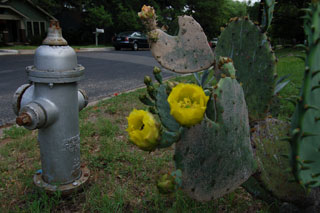Human Flower Project
Uh-Oh: Prickly Pear in Bloom
Global warming in our own front yard.

Opuntia robusta (Prickly pear cactus), April 17, 2006
Photo: Human Flower Project
The last breath of spring has coughed up a thorn.
Prickly pear cactus out on our corner has blossomed, bright yellow as lemon peel. This signals the end of spring in Texas and, alas, the onset of summer. It’s an evitable turn, of course—you can’t rein the seasons. The only problem is it’s all happening about three weeks too early.
This summer harbinger, combined with alarming stories we’ve read about too-early English wildflowers, Alaskan species blooming too early to reseed, has brought global warming up close and personal. Please check out these compelling sources on the subject. This site reports, among other disasters, that scientists say the world’s coral reefs will be dead in 50 fifty years. This website runs down the evidence on every continent. North American examples include no subzero days in Glasgow, Montana (1997); Edith’s Checkerspot Butterfly’s disappearance from the lower elevations of its range in California; 2.2 million acres of land burned in Nicaragua (1998); Colorado marmots emerging from hibernation 23 days earlier than in the past—and, oh yes, our cactus flowering three weeks too early.
Predicted high temperature today in Austin is 96 degrees. It’s only mid-April, people!

Record of rising global average temperatures
Hadley Centre for Climate Prediction and Research
UK Meteorological Office
Chart: via Ecobridge
At last year’s meeting of the American Association for the Advancement of Science, scholars blamed industry. “Records show that for the past 50 years or so, the warming trend has sped up—due, researchers said, to the atmospheric burden of greenhouse gases produced by everything industrial, from power plants burning fossil fuels to gas-guzzling cars—and the effects are clear.”
Want to learn more? Here’s an excellent library of resources covering all sides of the debate (for those still in the debating mood). Please send us your own anecdotal evidence to prove or disprove global warming. We’ll post all reports here.
One bright note: We’ve learned that the blooms of Opunta robusta, the relatively spineless variety of prickly pear in our yard, will last up to three days as cut flowers. We’re looking for scissors now.


Hi, Just a quick note to let you know more about the cactus in your photo. It isn’t O. robusta (a Mexican species), but rather it is a variant of O. lindheimeri (a Texas plant). It may be a different individual plant than David Griffith’s original, but probably it is the same. Sometime around 1910, He collected a plant at the mouth of the Devil’s River (now under Amistad Res.) and named it Opuntia subarmata (for the lack of spines). This is the type of O. lindheimeri (thick woody joints, but somewhat smaller plant size) that dominates in the area of the toward the Pecos and into the Big Bend, Davis, and Guadalupe Mountains. Most plants have a few down-curving stout short yellowish spines, but the original did not. It could be called O. lindheimeri var. subarmata, but I don’t think any botanist has yet made that combination official. So, you probably have a cutting of David Griffith’s original plant from near Del Rio (which is now scattered in gardens from Portland and Los Angeles to the Carolinas). Personally, I like it better than O. robusta, but they are both nice plants.
Best wishes,
Dave